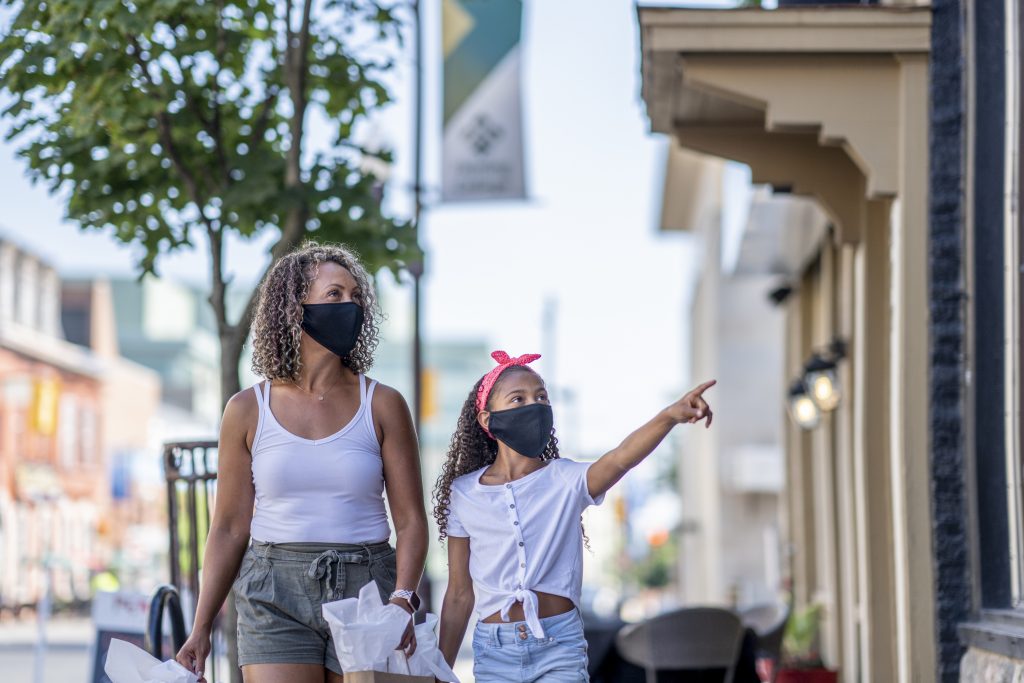What the Experts Want You To Know As Things Start to Reopen

With the reality that COVID-19 is not going anywhere yet, parents everywhere have had to adjust to a new normal. But as things open up, it can be confusing to know what’s safe and how to best approach the situation for you and your family.
We’ve partnered up with Maple, a virtual care platform that connects you with Canadian doctors in minutes from your phone, tablet, or computer, at any time 24/7, to bring you some great advice.
From an ER Physician
Dr. Brett Belchetz — ER Physician, CEO & Co-Founder of Maple
Just because we have started re-opening, doesn’t mean COVID has disappeared from our communities. You’ll need to make sure to exercise caution when choosing activities or places to attend.
Follow guidelines. If you’re taking your child to outdoor locations, such as the zoo or the pool, you want to carefully check on the precautions they are taking. Are they limiting the number of people allowed to enter to prevent crowding? Are they asking questions at the entrance to catch people with symptoms? Are staff actively managing social distancing and using their own protection such as sanitizer and masks? If the answers are no, you may want to steer clear.
Wear a mask. Current recommendations from medical authorities are to wear masks in all public spaces, especially indoors. Depending on where you live, there might even be laws mandating that masks are mandatory indoors. If your children are old enough to reliably wear a mask, make sure to get them masks and teach them how to use them. For children who are too young to wear masks properly, luckily there are some other solutions. Recent research has shown that face shields can be as good or better than masks for protection from virus transmission. Face shields are available in kid sizes, can be more easily worn by children, and can be beautified with decorations such as superhero stickers to amp up their appeal. They also have the added benefit of not interfering with spoken communication and facial expressions.
From a Sleep Expert
Getting enough rest is a very important way to keep your body healthy. The same goes for your kids’ health. Here are some ways to ensure they’re getting enough sleep at night to allow their bodies to rest and recover.
Keep bedrooms cool, quiet, and dark. Sleep can be easily interrupted, and taking steps to prevent external stimulation is a great way to sleep soundly. Cooler temperatures are better in the bedroom, as the body cools itself as a way to help the process of falling asleep. Quiet helps keep the brain free from external stimuli so it can conduct its sleep processes more efficiently. Darkness suppresses the visual stimulation that can keep us awake during the night.
Let the sun shine in. As important as it is to have darkness during sleep, it’s just as important to have exposure to light in the morning to help with regulation of our circadian rhythms. Open the blinds, take an early morning walk outside, or sit near eastern-exposed windows. These simple ideas can allow our bodies to fall asleep more easily at night.
Try to wake up at the same time every day – including weekends. Your body needs to be awake for a certain amount of time, and asleep for a certain amount of time. When you sleep later than your usual wake time, it can push your bedtime further back as well. This vicious cycle can be difficult to break and prevent you from feeling your best during the day.
From Mental Health Experts
Melissa Di Fonzo, Kelsey Block, Dorian Shwartz & Lisa Shwartz — Psychotherapists on Maple, through Shift Collab.
It’s safe to say that everyone has been affected by COVID-19, and taking our mental health seriously right now is crucial. Here are a few first steps.
Try different ways to manage stress. When we experience uncomfortable emotions – especially stress, anxiety, loneliness and anger — an instinctive reaction can be to avoid the feelings. Here are some healthy ways to manage stress, rather than suppressing it:
1) Allow yourself to feel the things you’re feeling
2) Make a to-do list to break down the tasks that are causing you stress
3) Call a friend and vent
Try not to dismiss your stress. Stress cycles have a beginning, middle, and end. This is important to note because if we dismiss or suppress stress, we miss the opportunity to work through it.
Write it out. When we’re feeling stressed, journaling can allow us to better process our thoughts and externalize any difficult feelings we may have had throughout the day. It can be a helpful tool in allowing ourselves to get to know what situations trigger us, how we process our thoughts and emotions, and how we might use our creativity to solve difficult problems.
Try to manage your inner critic. Think about a person in your life that inspires you. The next time you catch your inner voice being harsh and critical, try to channel that person’s voice and manner as inspiration. Try to validate your feelings in the same way that your important person would.
One More Tip: Talk to a Doctor online
We’ve heard countless stories of people not taking care of their health because they simply don’t know how to access their family doctor or they don’t feel safe going for in-person care. But repeat after us: the health of you and your family can’t be put on hold for COVID-19.
Maple connects you with licensed Canadian GPs in minutes from your phone, tablet, or computer, at any time 24/7 via secure text, audio or video call. If you’re looking for a specialist, like a dermatologist, psychiatrist or pediatrician, you can also book online consultations on your schedule without a referral.
The great thing is, Maple saves Canadians hours of time typically spent sitting in germy waiting rooms and days—or even months—of time waiting for appointments. Plus, Maple’s GP services are available in all provinces and territories.
Maple healthcare providers can treat hundreds of common conditions online, and you can receive a diagnosis, prescription, lab requisition or advice as necessary during your online consultation. And the Maple platform was built with security in mind. They are fully compliant with Canadian health guidelines and you remain in full control of any personal health information on the platform.
For more information on Maple, check out getmaple.ca
And to download the app, go here: app.getmaple.ca
Thanks to Maple for partnering with us on this informative post.













Post-pandemic transitions can be overwhelming. This expert advice is incredibly helpful in navigating the new normal. Thanks for sharing these insights!